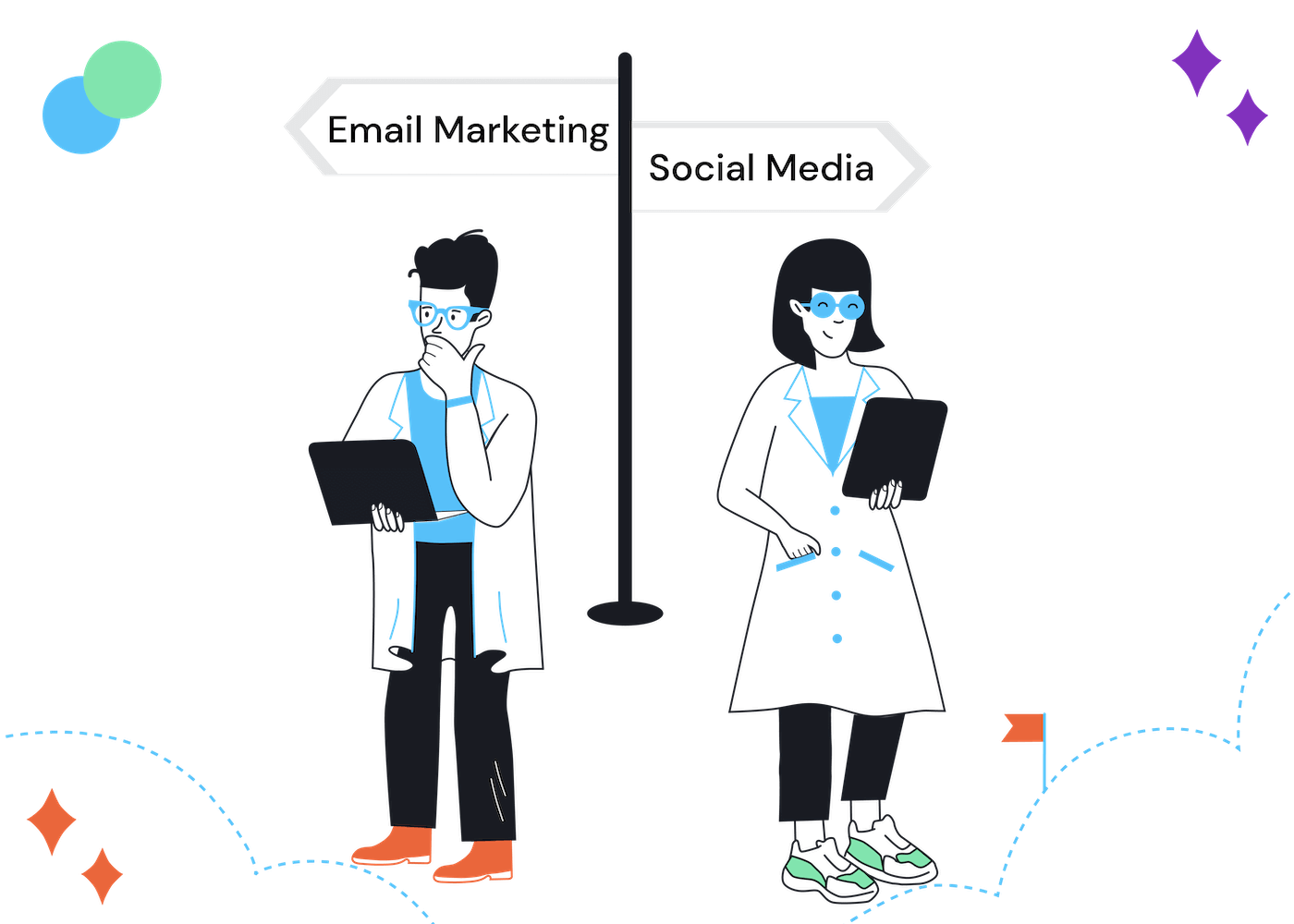With the increasing popularity of social media marketing, business owners often question the effectiveness of email marketing in today's world. But have no doubt: in 2025, email marketing is still a very valuable tool for businesses of all sizes.
In this article we will look at the main differences between social media and email marketing, and if you’re thinking about choosing one over the other, hopefully I can convince you that you need both!
Key Takeaway
While social media has a broad and almost infinite reach, email marketing’s reach is more targeted and limited. And while social media content tends to be diverse and entertaining, email marketing content is usually text and image based, and more informational.
The most successful digital marketing strategies use the strengths of both channels, in ways that complement each other. For example: using social media to build brand awareness and encourage email list sign up.
Key Social Media vs Email Marketing Metrics
| Social Media | ||
|---|---|---|
| Open / View rate: | 15-25% | 2-4% (organic) |
| Click-through rate: | 2.90% | 1.36% |
| Conversion rate: | 8% | 3% |
| ROI: | 3,500% | 180% |
| Maximum reach: | Limited to size of list | Unlimited |
See data sources below.
OK, let’s look at those differences in more detail, starting with the respective advantages of both social media and email marketing.
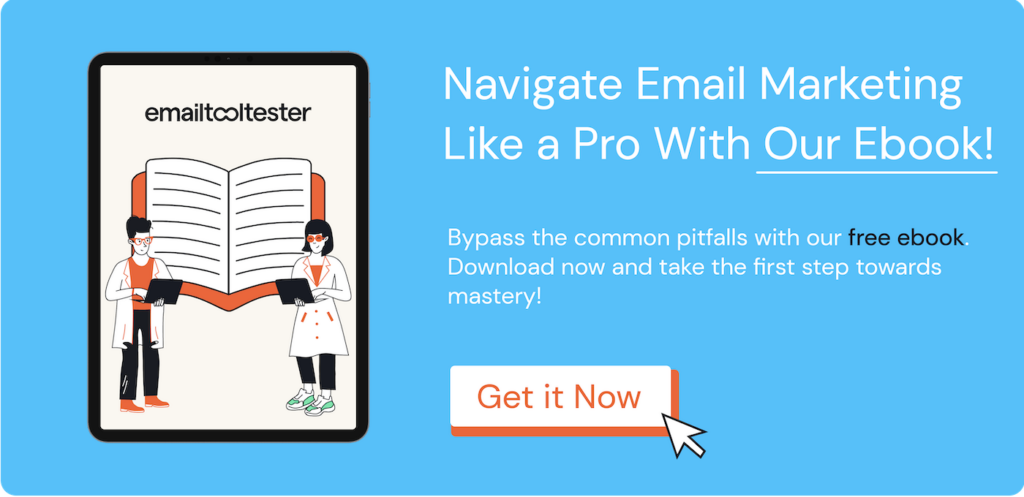
Pros of email marketing
- Targeted and personalized communication: Email marketing allows for targeted and personalized communication with customers and leads, increasing the likelihood of conversion.
- Higher open and click-through rates: Email has higher open and click-through rates compared to social media, as the recipient has explicitly opted-in to receive the content.
- Higher conversion rates: Email marketing is known for having a high return on investment (ROI) and can drive sales more effectively than social media, as it allows for targeted and personalized communication with customers and leads.
- Owned media: Email marketing provides businesses with a direct line of communication with their customers and leads, giving them control over their message and content.
- Measurable results: Email marketing provides clear metrics and analytics, allowing businesses to measure the success of their campaigns and make data-driven decisions.
Pros of social media marketing
- Wider reach: Social media marketing has a massive reach, with billions of monthly active users across multiple platforms (Instagram, X, Facebook, LinkedIn, Pinterest and also YouTube), making it an excellent tool for building brand awareness and reaching new audiences.
- Viral potential: Social media is designed to facilitate the sharing of information and content among users, making it easier to spread information and increase reach, potentially leading to viral campaigns.
- Real-time communication: Social media provides a platform for real-time communication with customers and leads, allowing businesses to respond quickly to customer inquiries and feedback.
- Greater visual appeal: Social media is a visual-focused platform, making it ideal for businesses looking to showcase their products and services through images and videos.
- Low cost: Social media is an inexpensive marketing channel, making it accessible for businesses of all sizes.
- Fast and flexible testing: Social media allows businesses to quickly test new ideas, campaigns, and content to gauge audience reaction, enabling fast iteration and optimization. If a post flops, you can also just delete it, unlike in email marketing.
Email Marketing vs Social Media: The Statistics
The following statistics should only be used as a guide s and your specific results may vary based on your target audience, the quality of your content, and the specific email or social media marketing campaign that is being executed.
Email Marketing Statistics
Open rates: On average, email open rates range from 15-25%. The exact open rate can depend on the subject line, sender reputation, and segmentation of the email list.
Click-through rates: The average click-through rate for emails is around 2.9%. Again, this can vary based on the specific email and its content.
Conversion rates: The average conversion rate for emails is around 8%. This can vary widely depending on the goals of the email, the product or service being sold, and the audience being targeted.
Return on investment (ROI): On average, for every $1 spent on email marketing, the average return is $36, which is 3,500% (in the retail, ecommerce, and consumer goods sector, ROI is higher with 45 dollars per one dollar spent).
Personalization: Personalized emails have higher open rates (26%) compared to non-personalized emails (15%).
Mobile optimization: Over 40% of all emails are opened on mobile devices, making it crucial for businesses to optimize their emails for mobile viewing. Most newsletter templates are now mobile responsive, but make sure to test them before sending them out!
> More statistics about email marketing here
Social Media Statistics
Engagement rates: Engagement rates on social media can vary widely depending on the platform, the type of content being shared, and the size of the audience. On average, engagement rates tend to be lower on social media compared to email marketing.
Click-through rates: The average click through rate for social media marketing in 2023 was 1.36%.
Reach: On average, organic reach for businesses is decreasing. In 2023, Instagram average reach rate is around 4%, Facebook’s average reach rate is only 2%.
Conversion rates: The average conversion rate for social media marketing is around 3%. However, this can be significantly higher for certain industries and products.
Return on investment (ROI): On average for every $1 spent, social media marketing generates a measly $2.80, which is just 180%.
Popular platforms: Facebook and Instagram are the most popular social media platforms, with billions of monthly active users.
Video content: Video content has a higher engagement rate compared to other types of content on social media, with video content accounting for over 80% of all internet traffic.
Influencer marketing: Influencer marketing on social media can drive significant results, with influencer marketing campaigns delivering 11x higher ROI compared to traditional forms of digital marketing.
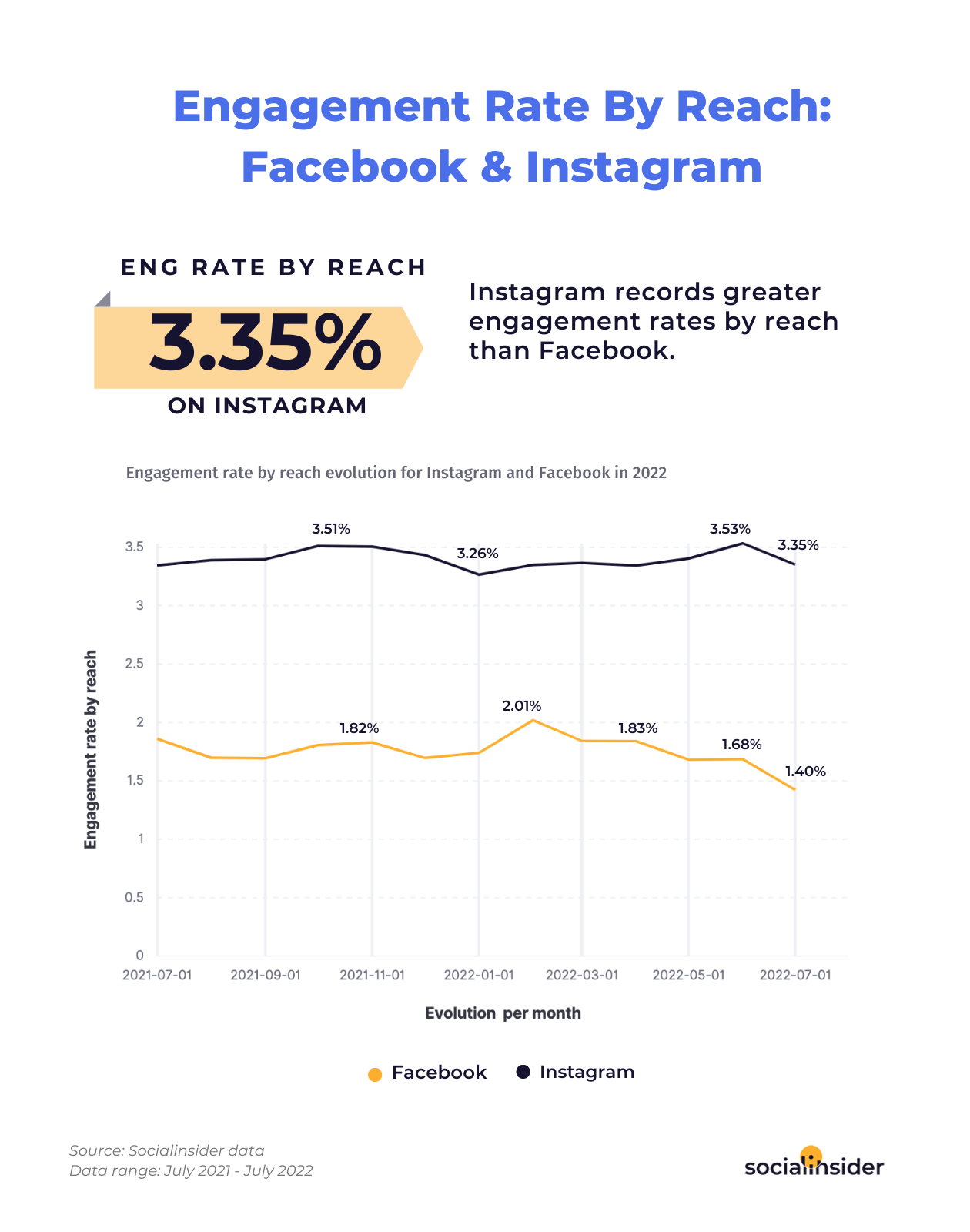
SocialInsider: Engagement rates for Facebook and Instagram
Email vs Social Media User Preferences
Everyone’s different, some people wake up and check their Instagram or Facebook page first thing in the morning, while others may head straight to their inbox. The user preferences for email vs social media are very much dependent on the individual and their specific needs and interests. However, here are some general observations:
Emails
Older demographic: Older individuals tend to prefer email as their primary means of communication, with seniors and baby boomers being more likely to check their email regularly.
Business communication: Email is often the preferred method of communication for business and professional purposes, as it provides a more formal and structured environment for exchanging information. If your target audience is B2B, email is for you.
Long-form content: Email allows for longer and more detailed messages, making it a good choice for conveying complex information or lengthy updates.
Social Media
Younger demographic: Younger generations, such as millennials and Gen Z, tend to prefer social media as their primary means of communication and information sharing.
Personal communication: Social media is often used for personal and casual communication between friends and family, and for sharing personal updates, photos, and videos.
Short-form content: Social media is designed for short and quick updates, making it a good choice for sharing short snippets of information or real-time updates.
This may not apply to every individual. You have to understand your target audience and which channels your audience prefer in order to reach them effectively. In some cases, businesses may find that a combination of both email and social media is the most effective approach.
Does Social Media Have a Greater Reach vs Email Marketing?
Email has a large reach, as it has been around for over four decades and is used by billions of people worldwide for personal and business communication. According to Statista, there are over 4.3 billion email users worldwide.
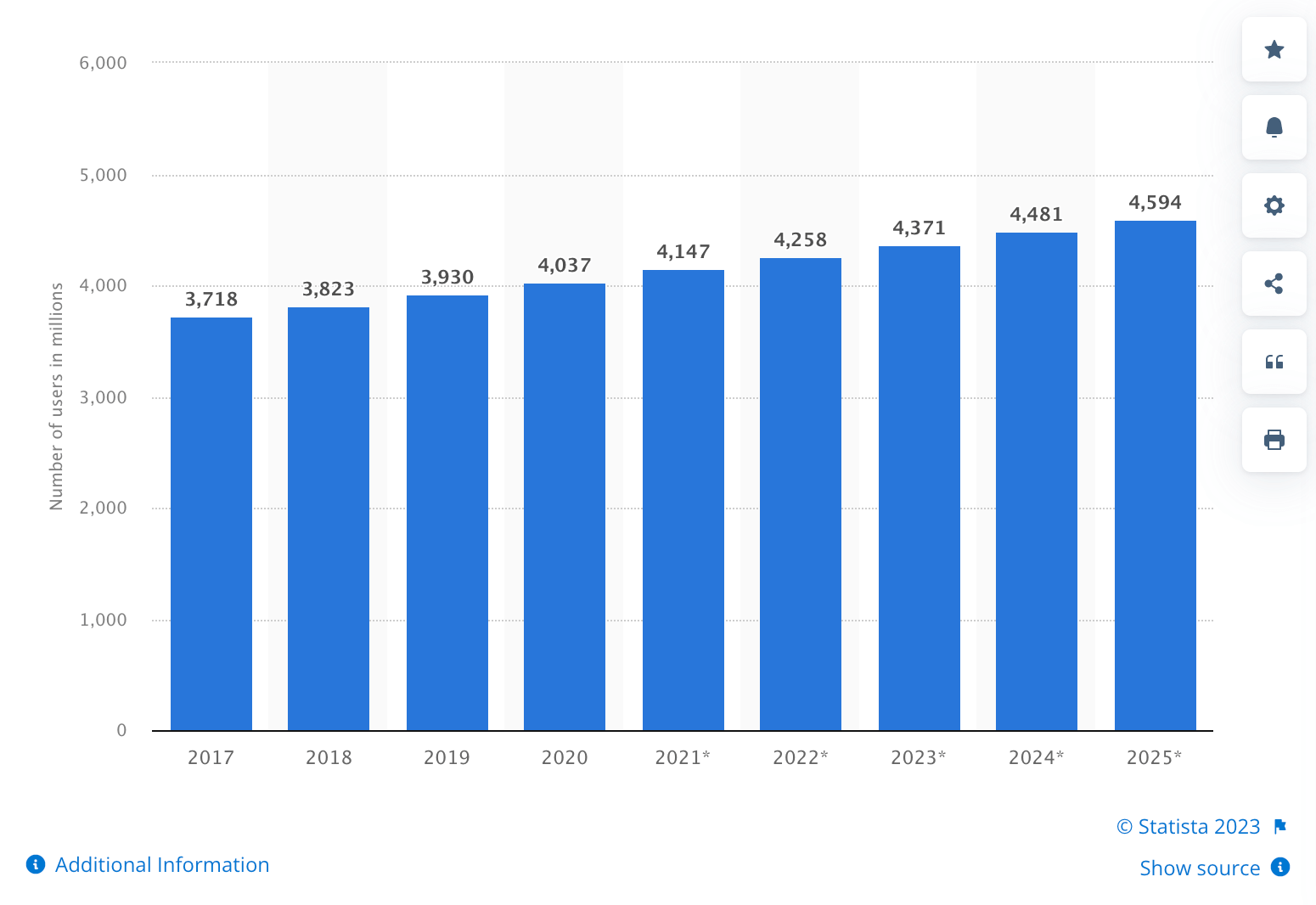
Statista: Number of e-mail users worldwide from 2017 to 2025 (in millions)
Social media has a massive reach, with billions of monthly active users across multiple platforms such as Facebook, Instagram, Twitter, and others. Social media has seen rapid growth in recent years, making it a crucial component of any digital marketing strategy.
Does Social Media Have More Viral Potential than Email Marketing?
Yes, social media marketing has the potential to be more viral than email marketing.
Social media is designed to facilitate the sharing of information and content among users, with features such as “share” and “like” buttons. This can lead to rapid and widespread dissemination of information, increasing the potential for viral reach.
Email marketing relies on the recipient forwarding the email to others or sharing the information through other means, like screenshots. While email can still be a powerful tool for spreading information, it may not have the same potential for rapid and widespread dissemination as social media.
However, note that just because social media has the potential for greater viral reach, it doesn't guarantee results.The success of a viral campaign depends on the quality of the content, the target audience, and the timing of the campaign. Businesses should carefully consider their target audience, the type of content, and the specific goals of their marketing campaign when deciding whether to use email marketing or social media.
Does Email Marketing Drive More Sales than Social Media?
Email marketing has a proven track record of driving sales, as it allows for targeted and personalized communication with customers and leads, and has a high return on investment (ROI).
Social media can be a powerful tool for building brand awareness and engaging with customers, but may not drive sales as directly as email marketing. However, social media can still play a crucial role in the sales process by increasing touchpoints, building brand awareness, establishing thought leadership, and driving traffic to a company's website or product pages.
Ultimately, the most effective approach is to use a combination of both email and social media in a holistic and integrated marketing strategy. This allows businesses to reach their target audience through multiple channels and drive results across the entire customer journey, from awareness to conversion.
Email Marketing ROI vs Social Media ROI
Email Marketing ROI
- High ROI: Email marketing is known for having a high ROI, with Statistica reporting businesses earning between $32-$45 for every $1 spent on email marketing. Of course, this depends on the industry. Retail and ecommerce saw the best results.
- Targeted and personalized communication: Email allows for targeted and personalized communication with customers and leads, increasing the likelihood of conversion.
Social Media ROI
- Lower ROI: Social media marketing generally has a lower ROI compared to email marketing, as the primary goal of social media is often to build brand awareness and engagement, rather than drive sales directly.
- Wider reach: Social media has a massive reach, with billions of monthly active users across multiple platforms. Facebook is said to have the highest ROI.
What is Best for a Small Business: Email Marketing or Social Media?
Email marketing can be a highly effective tool for small businesses, as it allows for targeted and personalized communication with customers and leads, has higher open and click-through rates compared to social media marketing and has a high return on investment (ROI). For these reasons, I’d definitely recommend putting together an email marketing strategy.
You may find our guide on how to collect emails for email marketing helpful if you’re just getting started – we also encourage you to refer to our email marketing checklist. We’ve also put together a list of the best email marketing services. You might be thinking Mailchimp is the best ESP, but we'd encourage you to check out our top Mailchimp alternatives first.
Nonetheless, social media can be an excellent tool for small businesses looking to build brand awareness and reach new audiences, as it has a massive reach, is designed for real-time communication, and is an inexpensive marketing channel.
Small businesses can use social media marketing to build brand awareness and reach new audiences and then use email marketing to engage with their existing customer base and drive sales.
Conclusion: How to Use Social Media and Email Marketing Together?
I guess the key takeaway from this article is the importance of having a well-rounded digital marketing strategy that incorporates both email marketing and social media marketing. Utilizing the strengths of each channel can help your business to reach its target audience effectively and drive results.
- Build your email list through social media: Encourage your followers on social media to sign up for your email list by offering exclusive content, discounts, or other incentives. You can promote your email sign-up form through posts, ads, or call-to-action buttons on your social media profiles.
- Share email content on social media: Share your email content, such as blog posts, promotions, and special offers on your social media profiles to increase reach and drive traffic back to your website.
- Connect your email and social media campaigns: Ensure that your email campaigns and social media campaigns complement each other and support your overall marketing goals. For example, you can use email to drive traffic to a social media contest or use social media to promote an email newsletter.
- Encourage social media engagement in your emails: Encourage your email subscribers to engage with your brand on social media by including social media handles and links in your emails.
- Analyze the results: Use analytics to track the results of your email and social media campaigns, and make data-driven decisions on how to improve your strategy.
Let us know how you’re using social media and email marketing to drive sales in the comments section below!
If you need help designing the perfect newsletter, check out our guide to email creation.
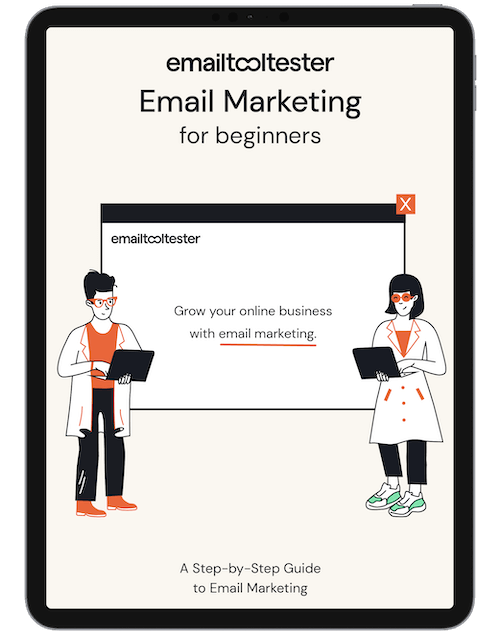
Email Marketing Ebook: Beginner's Guide
Sign up to receive your free copy and avoid common mistakes!
We keep our content up to date
08 Jan 2025 - Smaller updates
Our Methodology
This article has been written and researched following our EmailTooltester methodology.
Our Methodology